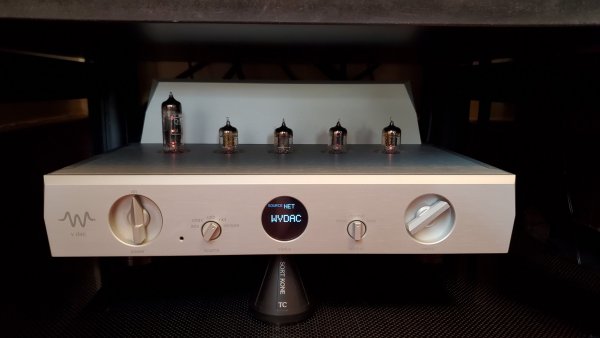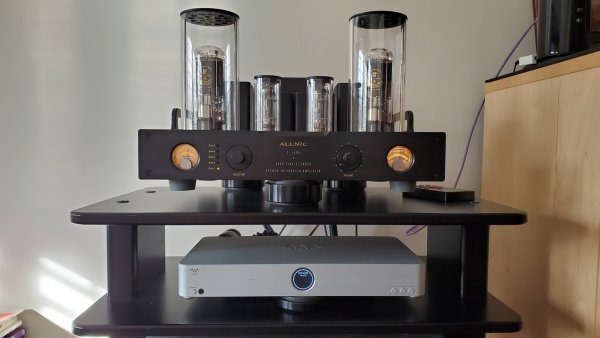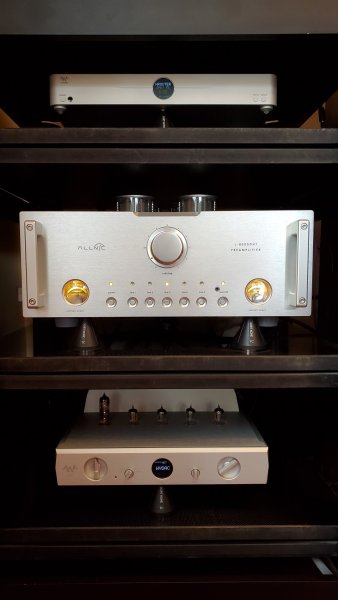WAVERSA VDAC
Conclusion:
The case for the Waversa tube rectified, tube output VDAC is a clear winner. The VDAC is a stunning piece of audio componentry, providing an incredibly live sounding musical experience; it’s also wonderfully flexible and solidly built. It is giving me more of the recorded music and more of a “musical” and “live” experience” than I’ve ever had from digital files.
The VDAC creates a deep, wide and high soundscape that becomes immersive as volume rises. It provides remarkable delineation and separation of instruments and voices, without “etch”, and with amazingly realistic timbres - and complete preservation of the “unity”, the “wholeness” of the body of the music at any volume level. Also at any volume, it unfailingly invites me to follow any instrumental or vocal line effortlessly, without becoming detached from the flow of the totality of the performance.
For the first time ever, my spouse, who, though probably possessing better hearing than I and being incredibly indulgent, has zero interest in audio equipment and my hobby, has started to sit beside me on the couch and, depending on the music, chat, and sometimes even just listen, regardless of volume. And that speaks volumes to me about what is going on in the room with the VDAC…
Facts:
As mentioned in my previous posts in computer audio, I’ve been using the Waversa WCore, WRouter and DAC3C. While I was very, very happy with the DAC3C, John at Kevalin Audio had a demo VDAC for sale, and… the DAC3C is now in my secondary system, where I was able to reduce the total number of boxes by one, since the DAC3C incorporates a renderer. It sounds great with the other components in that system, an Allnic T-1500 integrated amp and Omega speakers.
The VDAC is an extremely solid looking and feeling, and heavy, little block of metal. The Kevalin Audio website has photos and all the details, so I won’t provide much here; suffice it to say that the VDAC also incorporates a renderer and uses a tube output stage, with four Western Electric 408As and a 6X4 rectifier. Since it’s a Waversa product, like the DAC3C it works synergistically with the WCore and WRouter, providing all the benefits of Waversa’s WNDR processing. I should note that the VDAC is a true balanced tube/transformer output device. Depending on the implementation of the balanced inputs in a single-ended preamp, the combination might not work best with balanced interconnects, and single-ended RCA terminated interconnects would be the way to go.
Analysis:
I’ve been living with the VDAC for a couple of months now, and as I found with the DAC3C, it sounds best in my system using its internal renderer and connected via ethernet cable to the WRouter. Again, as with the DAC3C, using the VDAC as a WNDR source makes music sound more real than with Roon Raat (though I control play through Roon).
Was it worth it at three times the cost of the DAC3C? In my usual wholly subjective and relativistic manner, I can say yes, without hesitation or any degree of ambivalence. My impressions of what the VDAC does for my system and me? I’ll respond to the latter part of the question first, since it’s a simple answer: I’m enjoying my digital system and the music it produces more than ever before.
First part of the question… again, MORE: more soundstage in every dimension, more dynamics, more focus and palpability of instruments and voices, more correct timbres, more controlled bass, more open and transparent mids and highs: more lifelike in every way. I mean, really... this is a shock for me. At higher volumes, the VDAC can provide an incredibly immersive experience – it’s not more “they are in the room”; it’s more “you are in the room”, or at least more able to apparently share the space between the engineer’s ears.
At lower levels, the VDAC is a detailed and balanced window onto the stage, and one hears more, perfectly balanced, as the volume goes up. When the volume is set to “live” seeming sound-pressure levels, it’s as close to live music in my house as I’ve ever had from a digital source, transported from my modest little, wooden church like living room to… somewhere else.
Regardless of volume level, it is never fatiguing and very, very hard to stop listening to music from the VDAC. Also, at any volume level, the VDAC’s invitation to follow each instrumental and voice line in a performance is amazing. It is irresistible and wholly musically satisfying. There is so much…
I thought the DAC3C was not “digital” at all, as many have described that characteristic, but the VDAC sounds on par with my analog components (see system description in previous posts). On par, not “exactly the same”. While the DAC3C was incredibly satisfying, still, whenever I’d throw on a record, it seemed to give me more lifelike presence. With the VDAC, it’s a toss-up with the analog. I find the differences difficult to characterize, but they have nothing to do with the VDAC sounding in any way less lifelike, warm and detailed. It is just something about the feeling of “energy” I get from the analog side, energy not meaning speed and dynamic contrasts. The VDAC might actually be “cleaner”, with more of a black (not dead) background. There is “air” in abundance, but it’s somehow not exactly the same as the analog… but NOT at all inferior (I am talking about my system only, not generalizing beyond it).
Also, the VDAC sounds different and compares differently with the analog side depending on whether or not I have WAP/X engaged in the VDAC. With WAP/X in play, three-dimensionality of soundstage increases and there is more of that feeling of being in a larger and “live” air mass. In any event, both presentations are completely satisfying, though I find I am listening more with WAP/X in. But it depends to some degree on…
…the rectifier. My VDAC came with a Sylvania JAN 6X4WA. It’s great. I had a few different 6X4s, though, from rolling in a piece of gear I owned some years ago. Of course, I had to try them: GEC CV4005 (1980s round getter type), Brimar smoked glass 6X4 (square getter 1950s), Tung-Sol JTL 6X4W bent square getter (1950s). In the course of these fun and games, I also acquired a couple of 1950s square getter GEC CV4005 tubes. The winner? A toss up at the moment between the 1950s GEC and the Brimar. These two give me the deepest most articulate bass, the largest soundstage, and a beautiful airy and detailed top end. The Sylvania and the Tung-Sol and the ‘80s GECs present these things in different proportions. Consequently, which will work best is, I think, highly system dependent. Depending on one’s system, including room, one might want a bit more of this, a little more of that. One could say what they’re doing is a matter of “flavour”, of personal preference. That could be correct. Anyway, it’s great to have this degree of flexibility from changing the rectifier, in addition to - and in interaction with - all the other optional features of the VDAC (WAP/X, dynamics enhancement, variable resolution levels, for e.g.).
I have not tried any other 408A/6028s. The Western Electrics are famous for their sound quality and seem to be regarded generally as the best of this small tube, and I have zero doubts about them in the VDAC, so I have not yet acted on an urge to go down that rabbit hole. Nonetheless, if anyone has a suggestion and explanation for what might be an equally good or “superior” 408A/6028, I’d be curious to hear.
Conclusion:
The case for the Waversa tube rectified, tube output VDAC is a clear winner. The VDAC is a stunning piece of audio componentry, providing an incredibly live sounding musical experience; it’s also wonderfully flexible and solidly built. It is giving me more of the recorded music and more of a “musical” and “live” experience” than I’ve ever had from digital files.
The VDAC creates a deep, wide and high soundscape that becomes immersive as volume rises. It provides remarkable delineation and separation of instruments and voices, without “etch”, and with amazingly realistic timbres - and complete preservation of the “unity”, the “wholeness” of the body of the music at any volume level. Also at any volume, it unfailingly invites me to follow any instrumental or vocal line effortlessly, without becoming detached from the flow of the totality of the performance.
For the first time ever, my spouse, who, though probably possessing better hearing than I and being incredibly indulgent, has zero interest in audio equipment and my hobby, has started to sit beside me on the couch and, depending on the music, chat, and sometimes even just listen, regardless of volume. And that speaks volumes to me about what is going on in the room with the VDAC…
Facts:
As mentioned in my previous posts in computer audio, I’ve been using the Waversa WCore, WRouter and DAC3C. While I was very, very happy with the DAC3C, John at Kevalin Audio had a demo VDAC for sale, and… the DAC3C is now in my secondary system, where I was able to reduce the total number of boxes by one, since the DAC3C incorporates a renderer. It sounds great with the other components in that system, an Allnic T-1500 integrated amp and Omega speakers.
The VDAC is an extremely solid looking and feeling, and heavy, little block of metal. The Kevalin Audio website has photos and all the details, so I won’t provide much here; suffice it to say that the VDAC also incorporates a renderer and uses a tube output stage, with four Western Electric 408As and a 6X4 rectifier. Since it’s a Waversa product, like the DAC3C it works synergistically with the WCore and WRouter, providing all the benefits of Waversa’s WNDR processing. I should note that the VDAC is a true balanced tube/transformer output device. Depending on the implementation of the balanced inputs in a single-ended preamp, the combination might not work best with balanced interconnects, and single-ended RCA terminated interconnects would be the way to go.
Analysis:
I’ve been living with the VDAC for a couple of months now, and as I found with the DAC3C, it sounds best in my system using its internal renderer and connected via ethernet cable to the WRouter. Again, as with the DAC3C, using the VDAC as a WNDR source makes music sound more real than with Roon Raat (though I control play through Roon).
Was it worth it at three times the cost of the DAC3C? In my usual wholly subjective and relativistic manner, I can say yes, without hesitation or any degree of ambivalence. My impressions of what the VDAC does for my system and me? I’ll respond to the latter part of the question first, since it’s a simple answer: I’m enjoying my digital system and the music it produces more than ever before.
First part of the question… again, MORE: more soundstage in every dimension, more dynamics, more focus and palpability of instruments and voices, more correct timbres, more controlled bass, more open and transparent mids and highs: more lifelike in every way. I mean, really... this is a shock for me. At higher volumes, the VDAC can provide an incredibly immersive experience – it’s not more “they are in the room”; it’s more “you are in the room”, or at least more able to apparently share the space between the engineer’s ears.
At lower levels, the VDAC is a detailed and balanced window onto the stage, and one hears more, perfectly balanced, as the volume goes up. When the volume is set to “live” seeming sound-pressure levels, it’s as close to live music in my house as I’ve ever had from a digital source, transported from my modest little, wooden church like living room to… somewhere else.
Regardless of volume level, it is never fatiguing and very, very hard to stop listening to music from the VDAC. Also, at any volume level, the VDAC’s invitation to follow each instrumental and voice line in a performance is amazing. It is irresistible and wholly musically satisfying. There is so much…
I thought the DAC3C was not “digital” at all, as many have described that characteristic, but the VDAC sounds on par with my analog components (see system description in previous posts). On par, not “exactly the same”. While the DAC3C was incredibly satisfying, still, whenever I’d throw on a record, it seemed to give me more lifelike presence. With the VDAC, it’s a toss-up with the analog. I find the differences difficult to characterize, but they have nothing to do with the VDAC sounding in any way less lifelike, warm and detailed. It is just something about the feeling of “energy” I get from the analog side, energy not meaning speed and dynamic contrasts. The VDAC might actually be “cleaner”, with more of a black (not dead) background. There is “air” in abundance, but it’s somehow not exactly the same as the analog… but NOT at all inferior (I am talking about my system only, not generalizing beyond it).
Also, the VDAC sounds different and compares differently with the analog side depending on whether or not I have WAP/X engaged in the VDAC. With WAP/X in play, three-dimensionality of soundstage increases and there is more of that feeling of being in a larger and “live” air mass. In any event, both presentations are completely satisfying, though I find I am listening more with WAP/X in. But it depends to some degree on…
…the rectifier. My VDAC came with a Sylvania JAN 6X4WA. It’s great. I had a few different 6X4s, though, from rolling in a piece of gear I owned some years ago. Of course, I had to try them: GEC CV4005 (1980s round getter type), Brimar smoked glass 6X4 (square getter 1950s), Tung-Sol JTL 6X4W bent square getter (1950s). In the course of these fun and games, I also acquired a couple of 1950s square getter GEC CV4005 tubes. The winner? A toss up at the moment between the 1950s GEC and the Brimar. These two give me the deepest most articulate bass, the largest soundstage, and a beautiful airy and detailed top end. The Sylvania and the Tung-Sol and the ‘80s GECs present these things in different proportions. Consequently, which will work best is, I think, highly system dependent. Depending on one’s system, including room, one might want a bit more of this, a little more of that. One could say what they’re doing is a matter of “flavour”, of personal preference. That could be correct. Anyway, it’s great to have this degree of flexibility from changing the rectifier, in addition to - and in interaction with - all the other optional features of the VDAC (WAP/X, dynamics enhancement, variable resolution levels, for e.g.).
I have not tried any other 408A/6028s. The Western Electrics are famous for their sound quality and seem to be regarded generally as the best of this small tube, and I have zero doubts about them in the VDAC, so I have not yet acted on an urge to go down that rabbit hole. Nonetheless, if anyone has a suggestion and explanation for what might be an equally good or “superior” 408A/6028, I’d be curious to hear.













